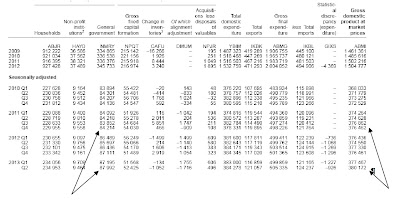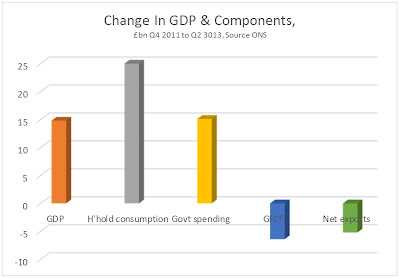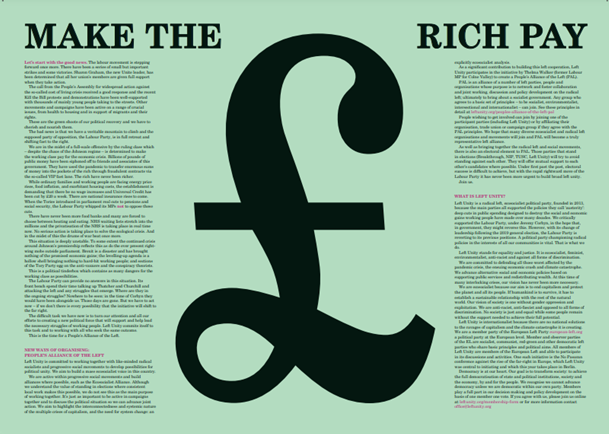Did austerity lead to recovery?
Did austerity lead to recovery? No, GDP was increased by government spending, says economist Michael Burke
The government and its supporters have been quick to claim that the most recent GDP data have vindicated its austerity policy. George Osborne says the argument in favour of austerity has been won and some more excitable commentators have even talked of a boom.
Usually, I would provide analysis of the GDP data after the publication of the national accounts, the third release in the cycle from the Office of National Statistics, which provides a detailed breakdown of the components on economic activity and the final revision to the data.
But the claims made for the British economy following the most recent GDP release (and some subsequent surveys) are so outlandish, and so at odds with the facts, that is worth providing a short analysis now. The data is still partial and subject to revision. But there is enough evidence to demonstrate factually that the weak recovery is not a reward for austerity, but is in fact entirely a function of increased government spending.
The economy has expanded by just 1.8% in 3 years of austerity, an annual rate of 0.6% which is less than one-quarter of previous trend growth. The gap between the current level of GDP and trend growth for the British economy is widening. In addition, the growth to date is entirely a function of increased government spending.
Factual Analysis
This verdict is so at odds with both stated government policy and the overwhelming commentary on the latest data. Therefore it is important to provide the hard evidence supporting this analysis. The can be found on Table C2 of the latest release, Second Estimate of GDP, Q2 2013 (ONS).
Total government current spending was barely changed from the time the Coalition took office to the end of 2011. (In the ordinary course of events real government spending should rise in line with population growth and in a recession should rise much faster to offset the effects of recession. Unchanged government spending represents a harsh ‘austerity’ stance).
However, from the 4th quarter of 2011 to the 2nd quarter of 2013 government current spending has risen decisively by an annualised £15.1bn. GDP did not begin to expand until two quarter later. This is the time lag SEB has previously identified in the relationship between changes in government spending and changes in GDP. Rising government spending has led the recovery.
While the increase in government spending since the 4th quarter of 2011 to the most recent quarter amounts to £15.1bn, the rise in aggregate GDP over the same period is just £14.8bn. Therefore, the rise in government spending not only led the recovery, but more than accounts for the entire expansion over the same period (as some other components of GDP have contracted).
Rising government current spending tends to support consumption, which is exactly what has happened over the last 18 months. The rise in household consumption has been the strongest of all components of GDP over that period, rising by £25bn. The chart below shows the changes in the national accounts since the government began increasing its current spending after the 4th quarter of 2011.
But weak household spending is not the source of the crisis. This remains the slump in investment. GDP is still £50bn below its previous peak in the 1st quarter of 2008, but investment (Gross Fixed Capital Formation) is £65bn lower. Household consumption also remains below £24bn its pre-recession peak. But it has been rising continuously for 2 year and now accounts for under half of the total decline in GDP. The fall in GFCF more than accounts for the entire fall in GDP.
It is not possible from the partial release of the data for the 2ndquarter of 2013 to establish the role of government in the continuing investment strike. But from the 1st quarter national accounts, it is clear that declining government investment has been exacerbating the private sector decline in investment. Government investment peaked under the last Labour government and has been cut continuously ever since.
But the analysis is confirmed by the separate ONS data on public finances. The presentation of the public finances data vary significantly from the presentation of government consumption data in the national accounts. Among the many differences is that the former are presented in nominal terms only. Even so, these show (Table PSF5) that in nominal terms the level of departmental outlays rose to £305bn in the first half of 2013, from £283bn in the same period of 2012. This is a rise of 7.8% and way above the rate of inflation.
Conclusion
There is no mystery to the current very weak recovery. It is led by a moderate increase in government spending, which more than accounts for the entire increase in GDP over the same period.
This runs counter to the government’s stated ‘austerity’ policy. But it is accompanied by a cut in government investment, which exacerbates the private sector investment strike. It is this investment strike which remains the source of the crisis, which cannot be resolved by increasing current spending.
Logic would dictate that any government which wanted to support the economy would increase investment, which is the source of the crisis. Conversely, any government fixated on deficit reduction would probably be inclined to cut both current and capital spending.
This government is committed to neither economic recovery nor deficit-reduction. Instead, it is committed to boosting profits. That is why it is willing to increase current spending which supports consumer demand but refuses to increase investment as this would displace private capital from potentially profitable sectors of the economy.
Since this government is not sticking to its own spending plans, it makes even less sense for an incoming Labour government to do so. Instead, it needs to address the source of the crisis by increasing state investment.
This article was first posted on Socialist Economic Bulletin
4 comments
4 responses to “Did austerity lead to recovery?”
Left Unity is active in movements and campaigns across the left, working to create an alternative to the main political parties.
About Left Unity
Read our manifesto
Left Unity is a member of the European Left Party. 
Read the European Left Manifesto
ACTIVIST CALENDAR
Events and protests from around the movement, and local Left Unity meetings.

Saturday 29th November: National Demonstration for Palestine
END THE OCCUPATION – STOP ARMING ISRAEL – END APARTHEID
12 noon central London
More events »
GET UPDATES
Sign up to the Left Unity email newsletter.
CAMPAIGNING MATERIALS
Get the latest Left Unity resources.






Great article. It is interesting just how utterly incapable Ed Balls and co themselves are of exposing the sham “happy days are here again” propaganda barrage from the Tories and their mass media allies, when interviewed about the “great recovery” statistics on the TV. They feel able to point out the continuing fall in ordinary household incomes, and the real continuing long term unemployment and inadequate hours employment problem, but challenge the central “austerity is necessary, and working ” narrative ? No.
It will be interesting just how effective This bogus “happy days are here again” propaganda offensive will be in the lead up to the next General election in boosting the Tory (and Lib Dem ?) vote, given that for most people the personal falling income and rising inflation reality is so at variance with the propaganda message.
The reality of course is that, effective as all these Tory economic measures have been in directing national income as profits to the private sector, the national and world economic picture is still one of stagnation and crisis – with the previously buoyant “BRICS” economies now deeply into currency, trade imbalance and falling growth difficulties too. Capitalism needs to squeeze a lot more surplus value out of us all yet, and find a long term new growth path, before we see the real end of this systemic crisis.
Agreed – an excellent analysis. Any government that tries to base its message on GDP alone – which can’t tell the difference between manufacturing and oil spills, and is blind to the money markets – needs to be exposed in this way.
But the real elephant in the room is the fact that the capitalist system is fundamentally reliant on growth – in the sense of continuous increase in consumption of resources. Just as any other kind of addict, it cannot function in any useful way without its regular fix. As the article points out, lack of growth leads to an investment strike, etc, etc. Conversely, ‘normal’ exponential growth in today’s crowded world inevitably leads to resource wars and rapid climate change, with all of the well known consequences hitting the most vulnerable people hardest. There is no such thing as a satisfactory ‘long term growth path’ in the current meaning of the phrase.
That is why we have to pick up where Marx left off, and design a system of production which is not dependent on growing consumption, but is still able to facilitate improvements in the quality of life. Much work to do!
What austerity? Is the deficit cut? Barely. Is the national debt cut? No it is hugely increased. Is the public sector borrowing requirement less? No the bogus borrowing figures of Osborne have been plastered over by QE and selling the last of the family silver. Royal Mail will raise £3 billion.
The only people who have suffered any austerity is the poor, young, old, sick, disabled and working people whilst the state is bankrupting itself propping up bankrupt banks, funneling public money through the NHS and Education to privateers, debasing the currency and financing a mini housing bubble. This government is as Keynesian as THatchers and Blairs when it comes to ruling class interests.
Let us make no mistake though. Capitalism has grown as far as it can. It is globalised, monopolised, sclerotic and bankrupt. It is a system no longer capable or reproducing itself. Only the monopolists have cash, mounds of it, and they will not be spending that on anything other than fascist gangs and war as investment would simply undermine their dominant position. Monopoly profits and cash hoarding, the collapse in the disposable income of the masses and the state and the bankruptcy of the financial sector points to an inevitable global depression from which capitalism will never be able to escape.
Debt fuelled consumers and rising house prices are driving the recovery of the economy. The capitalist class and the liberal media outlets continue to speak of the economy or the recovery as if it was one, uncontested entity. In reality Householders are being squeezed doubly by this so called recovery. Austerity measures. Unemployment and wage cuts all gathering pace as credit has been made more readily available to households.Meanwhile the housing market is booming again,which means private tory landlords are profiteering as swathes of the working classes are being socially cleansed out of inner London.
the very notion of ‘one economy’ the idea that ‘we are all in this together’ needs to be fundamentally called into question when we read these political_economic pronouncements lauding austerity and recovery. We need to bring the challenge of class struggle to the table in order to see the truth of the divisions and exploitation by the capitalist class and their supporting government and liberal media muppet mouthpieces.